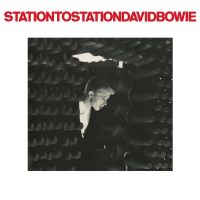 Written by: David Bowie
Written by: David Bowie
Recorded: October-November 1975
Producers: David Bowie, Harry Maslin
Released: 23 January 1976
Available on:
Station To Station
Live Nassau Coliseum ’76
Stage
Welcome To The Blackout (Live London ’78)
Serious Moonlight (Live ’83)
Glastonbury 2000
Personnel
David Bowie: vocals, guitar
Carlos Alomar, Earl Slick: guitar
Roy Bittan: piano
George Murray: bass guitar
Dennis Davis: drums, tambourine
Geoff MacCormack: vocals
‘Station To Station’ was the title track of David Bowie’s tenth studio album, and his longest released song: a dazzling, multi-part epic which took in the occult, religious mysticism and Shakespeare, and introduced his new persona – the Thin White Duke.
The ‘Station To Station’ track itself is very much concerned with the stations of the cross, All the references within the piece are to do with the Kabbalah. It’s the nearest album to a magik treatise that I’ve written. I’ve never read a review that really sussed it. It’s an extremely dark album. Miserable time to live through, I must say.
Q magazine, February 1997
The Station To Station album was created during a period of personal turmoil for Bowie. He was in the midst of a chronic cocaine addiction, was embroiled in a long-running lawsuit to end his management contract with MainMan, was disillusioned with the music industry, and his marriage was falling apart.
Bowie was burnt out, paranoid, drug addicted, and barely subsisting on a diet of pure coke, milk, and finely chopped red peppers. He later said he barely remembered anything of the album’s creation.
I would say a lot of the time I spent in America in the ’70s is really hard to remember, in a way that I’ve not seen happen to too many other artists. I was flying out there – really in a bad way. So I listen to Station To Station as a piece of work by an entirely different person.
Q magazine, February 1997
He was also disillusioned with Los Angeles, where he lived for much of 1975. He was looking increasingly towards Europe, influenced by the innovative sounds of musicians such as Kraftwerk and Brian Eno.
The reasons for doing the show and record were many-faceted. The overriding need for me was to develop more of a European influence, having immersed myself so thoroughly in American culture. As I was personally going through a very bad time, I thought I had to get back to Europe. So it came to that.
Musician magazine, May 1983
There was no enjoyment in the working process [in America]. I’d exclude from that Station To Station. That was fairly exciting because it was like a plea to come back to Europe. It was one of those self chat things one has with oneself from time to time.Christ, no… what am I talking about? A lot of that and Young Americans was damn depressing. It was a terribly traumatic time. I was absolutely infuriated that I was still in rock ‘n’ roll. And not only in it, but had been sucked right into the centre of it. I had to move out. I never intended to be so involved in rock and roll… and there I was in Los Angeles, right in the middle of it.
Whether it’s fortunate or not I don’t know, but I’m absolutely and totally vulnerable by environment, and environment and circumstances affect my writing tremendously. To the point of absurdity sometimes.
I look back on some things in total horror… And anyway I began to realise that the environment of Los Angeles, of America, was by this time detrimental to my writing and my work. It was no longer an inspiration to be caught in that environment.
I realised that that was why I was feeling so claustrophobic and cut off. I was adopting such a hypocritical stance. There was this incredible fight between materialism and aestheticism. My commitment has certainly never been in rock ‘n’ roll. I’ve made no secret of that. I was just a hack painter who wanted to find a new medium to work in, frankly.
Melody Maker, 29 October 1977
Bowie later cited the song ‘Station To Station’ as paving the way for the sound of the ‘Berlin’ trilogy of Low, “Heroes”, and Lodger.
As far as the music goes, Low and its siblings were a direct follow-on from the title track ‘Station To Station’. It’s often struck me that there will usually be one track on any given album of mine, which will be a fair indicator of the intent of the following album.
Uncut, January 2001
In October 1980, Bowie filmed a brief cameo for the Herman Weigel feature film Christiane F. Although most of the film was made in Berlin, Bowie’s footage, during which he lipsynced to the Stage version of ‘Station To Station’, was shot at the Hurrah club on 32 West 62nd Street, Manhattan.


Correction to be made: Station to Station did not introduce Bowie’s ninth stage persona, the Thin White Duke, but instead reintroduced him to his devoted fans, for this persona was created five years prior and was a finalised reawakening of the Thin White Duke that Bowie’s fans longed for him to recreate or reintroduce. The Thin White Duke was one of two byproducts of Ziggy Stardust, who he officially killed off in 1975…I know I was at Ziggy’s last concert in New York when Bowie announced it before finishing the show with Rock ‘n’ Roll Suicide…horrifying fans with the words “…for it will be the last song that we will ever do.” Please do your research more cleverly. There are several problems with Bowie Bible, far too many for me to list in this comment box. Please contact me, I am sure I can be a service to Bowie Bible. I intimately know everything about the man.
Cheerio.